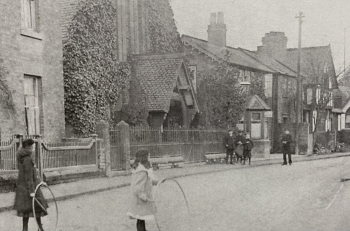Serving up another taste of history – cocoa-ing back in time
(Posted on 18/03/24)

As our previous article on the history of our new Zebra HQ (aka The Cocoa Rooms) proved so popular, we couldn’t resist expanding our research to find out more about the historic building which Zebra now calls home.
With plenty of gaps in our knowledge as to the history of the building, we felt it was only right to continue to piece together this intriguing puzzle.
We would therefore like to thank Cllr Helen Maurice-Jones of the Rossett Community Council, and Mary Andrews of the Balfour Trust for their information and contacts, and Gwyneth Jones and Marion Woodward, living sources of history to the Cocoa Rooms.
The grand opening
The building was officially opened on Saturday 22 October 1884 by a member of the aristocracy, His Grace Hugh Grosvenor, the 1st Duke of Westminster, whose seat was at the nearby Eaton Hall. Also in attendance was the duke’s second wife Countess Katherine Grosvenor, and Lady Beatrice Cavendish, the second daughter of the duke.
It is interesting to note that Lady Beatrice Cavendish was not only Katherine Grosvenor’s step-daughter-in-law, but also her sister-in-law, as she was married to Katherine’s eldest brother Charles Cavendish, 3rd Baron of Chesham. He was Lady Beatrice’s second cousin. A close family indeed.
The Rossett Parish magazine from November 1881 reported the auspicious occasion;
“The day was most unfortunate, as the rain which had commenced about noon, never ceased to come down. Notwithstanding, there was a very large attendance, and many coming from a considerable distance.”
The building was opened as ‘The Cocoa House and Dairy’, where “good and wholesome milk could be supplied”. The building consisted of a ‘Refreshment Room’, where local school children from the Rossett National School, which once presided next door (but is now a car park), could enjoy milk or hot cocoa, and purchase dinner with it, or bring theirs from home!
It was also to be used as a Working Men’s Club and Reading Room, open from 6pm-10pm each evening), where members could enjoy reading or recreation outside of the temptations of Public Houses. It was recommended for all “who sought recreation out of their own homes to seek it at The Cocoa House”.
Custodians of the Cocoa
From researching various censuses, we have discovered that by 1891 the Cocoa Rooms was being run by Robert J. Jones (the ‘Refreshment House Keeper’) and his wife Mary E. Jones (nee Griffiths). At this time, they resided at The Caretaker’s Cottage next door to the Cocoa Rooms with their three children Albert, Berty and Elsie. Also residing with them as boarders were William Griffiths (Mary’s brother) Alfred Dodd, Ruth Dodd and Annie Norman. William and Alfred were listed as bakers, Ruth was a waitress, and Annie was the family’s servant.
During their time there, the Jones’ were reported in the Wrexham Advertiser on Saturday 13 August 1892 as having supplied “a good tea” at the Cocoa Rooms after the congregation from the Presbyterian Chapel down the road enjoyed a day out by train to the seaside at West Kirby.
By the next census 10 years later in 1901, Robert was listed as a Confectioner, so it is unclear as to whether he was still a custodian of the Cocoa Rooms, or who was then running it.
However, we do know that by 1939, William (Bill) Randles was the caretaker of the Cocoa Rooms (or The Institute).
One of seven brothers, six of them served during the First World War. All of the brothers, remarkably, returned, although sadly William was wounded at Ypres in 1917. Aged only 19, he lost his right leg, and suffered fractures to his left leg and a bullet through his left arm. He was finally discharged from hospital in 1920, and whilst there he embroidered the emblem of the Royal Welsh Fusiliers, as he had served in the 4th Battalion. This now hangs at BLESMA in Blackpool.
Upon his return he met Annie Elizabeth Tanner (or Tannar according to the 1901 census) from Llanidloes in Montgomeryshire, and they married in 1923. They had a daughter, Monica in 1930. They later adopted Marion, Annie’s brother’s daughter, after she came to live with them in 1941.
During the Second World War, William served in the voluntary fire service at Lavister, and could have been on duty when a German bomber, returning from a raid on Liverpool, was forced to land somewhere between Pulford and Poulton, potentially at the RAF Poulton airfield used between 1943-1945 to train Hurricane pilots. The fire service was first onto the scene, so William could have been one of the first to come face to face with ‘the enemy’.
The Randles family lived at The Caretakers Cottage until 1966, and Marion fondly remembers her childhood there. She used to enjoy ‘playing shop’, greeting visitors to the Cocoa Rooms at the front desk and taking orders for their afternoon tea and, of course, hot cocoa.
Gwyneth Jones lived two doors down from the Cocoa Rooms, and remembers visiting and attending for the Young Conservatives meetings in the 1950s. Her family and the Randles were close, and Marion’s adoptive mother Annie crocheted a beautiful table cloth for Gwyneth as a wedding present, which she still has. Her father, Alfred Evans (one of the local butchers), often played billiards in the pool room upstairs of the Cocoa Rooms.
We are still unsure as to who then cared for the Cocoa Rooms, aside from the Balfour Trustees, and when the building became the NatWest Bank. However, we will continue to research and report on this building’s fascinating and colourful history!
In the meantime, who’d like a hot chocolate?







